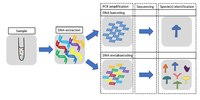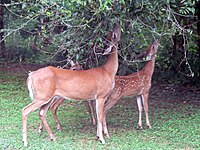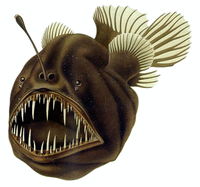
On the Origins of Fracture Toughness in Advanced Teleosts: How the Swordfish Sword's Bone Structure and Composition Allow for Slashing under Water to Kill or Stun Prey
Sign Up to like & getrecommendations! Published in 2019 at "Advanced Science"
DOI: 10.1002/advs.201900287
Abstract: Abstract The osseous sword of a swordfish (Xiphias gladius) is specialized to incapacitate prey with stunning blows. Considering the sword's growth and maturation pattern, aging from the sword's base to the tip, while missing a… read more here.
Keywords: prey; sword; bone; advanced teleosts ... See more keywords

Growth and tissue nutrient responses of adults of Sarracenia alata to prey exclusion, nutrient addition, and neighbor reduction.
Sign Up to like & getrecommendations! Published in 2022 at "American journal of botany"
DOI: 10.1002/ajb2.16107
Abstract: PREMISE Carnivorous plants are often associated with nutrient-poor soils and fires. Fire can decrease available soil nitrogen (N) and increase light availability, thus potentially favoring carnivory if prey provide N. Prey can also be a… read more here.
Keywords: growth; prey; neighbor reduction; soil ... See more keywords

Diet of a threatened rattlesnake (eastern massasauga) revealed by DNA metabarcoding
Sign Up to like & getrecommendations! Published in 2023 at "Ecology and Evolution"
DOI: 10.1002/ece3.10029
Abstract: Abstract Characterizing the diet of imperiled species using minimally invasive methods is crucial to understanding their ecology and conservation requirements. Here, we apply a DNA metabarcoding approach to study the diet of the eastern massasauga… read more here.
Keywords: dna metabarcoding; ecology; prey; eastern massasauga ... See more keywords

Optimal prey for red fox cubs—An example of dual optimizing foraging strategy in foxes from a dynamic wetland habitat
Sign Up to like & getrecommendations! Published in 2023 at "Ecology and Evolution"
DOI: 10.1002/ece3.10033
Abstract: Abstract The red fox (Vulpes vulpes) is the most abundant mesopredator in the Central European region. Detailed knowledge about their feeding behavior is important both from ecological and wildlife management reasons. Food choices of foxes… read more here.
Keywords: fox; food; dual optimizing; red fox ... See more keywords

Retention of essential fatty acids in fish differs by species, habitat use and nutritional quality of prey
Sign Up to like & getrecommendations! Published in 2023 at "Ecology and Evolution"
DOI: 10.1002/ece3.10158
Abstract: Abstract Algae‐produced long‐chain polyunsaturated fatty acids (LC‐PUFA; with ≥20 carbon atoms) are key biomolecules for consumer production and animal health. They are transferred to higher trophic levels and accumulated in food chains. However, LC‐PUFA accumulation… read more here.
Keywords: ecology; retention; quality; pufa ... See more keywords

Hunting‐mediated predator facilitation and superadditive mortality in a European ungulate
Sign Up to like & getrecommendations! Published in 2018 at "Ecology and Evolution"
DOI: 10.1002/ece3.3642
Abstract: Abstract Predator‐prey theory predicts that in the presence of multiple types of predators using a common prey, predator facilitation may result as a consequence of contrasting prey defense mechanisms, where reducing the risk from one… read more here.
Keywords: prey; predator facilitation; hunting mediated; predator ... See more keywords

Reversed predator–prey cycles are driven by the amplitude of prey oscillations
Sign Up to like & getrecommendations! Published in 2018 at "Ecology and Evolution"
DOI: 10.1002/ece3.4184
Abstract: Abstract Ecoevolutionary feedbacks in predator–prey systems have been shown to qualitatively alter predator–prey dynamics. As a striking example, defense–offense coevolution can reverse predator–prey cycles, so predator peaks precede prey peaks rather than vice versa. However,… read more here.
Keywords: prey; predator prey; prey biomass; reversed cycles ... See more keywords

Longitudinal variation in fish prey utilization, trophic guilds, and indicator species along a large subtropical river, China
Sign Up to like & getrecommendations! Published in 2018 at "Ecology and Evolution"
DOI: 10.1002/ece3.4577
Abstract: Abstract Due to the heterogeneous distribution of resources along large rivers, understanding prey utilization by basin‐scale fish assemblages remains a challenge, and thus, recognizing regional fish trophic guilds and indicator species is important. We analyzed… read more here.
Keywords: prey; indicator species; prey utilization; river ... See more keywords

Messy eaters: Swabbing prey DNA from the exterior of inconspicuous predators when foraging cannot be observed
Sign Up to like & getrecommendations! Published in 2019 at "Ecology and Evolution"
DOI: 10.1002/ece3.4866
Abstract: Abstract Complex coevolutionary relationships among competitors, predators, and prey have shaped taxa diversity, life history strategies, and even the avian migratory patterns we see today. Consequently, accurate documentation of prey selection is often critical for… read more here.
Keywords: prey; study; prey dna; messy eaters ... See more keywords

Aggressive mimicry in a coral reef fish: The prey's view
Sign Up to like & getrecommendations! Published in 2020 at "Ecology and Evolution"
DOI: 10.1002/ece3.6883
Abstract: Abstract Since all forms of mimicry are based on perceptual deception, the sensory ecology of the intended receiver is of paramount importance to test the necessary precondition for mimicry to occur, that is, model‐mimic misidentification,… read more here.
Keywords: prey; coral reef; model; mimicry ... See more keywords

Numbers, neighbors, and hungry predators: What makes chemically defended aposematic prey susceptible to predation?
Sign Up to like & getrecommendations! Published in 2020 at "Ecology and Evolution"
DOI: 10.1002/ece3.6956
Abstract: Abstract Many chemically defended aposematic species are characterized by relatively low toxin levels, which enables predators to include them in their diets under certain circumstances. Knowledge of the conditions governing the survival of such prey… read more here.
Keywords: prey; defended aposematic; hungry predators; species prey ... See more keywords